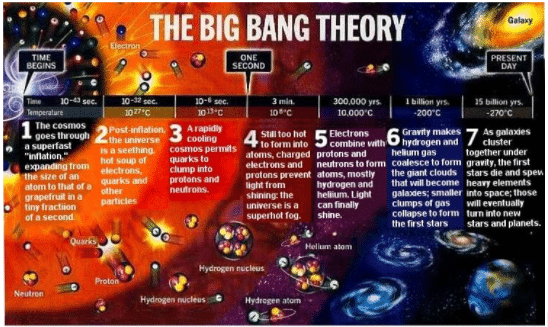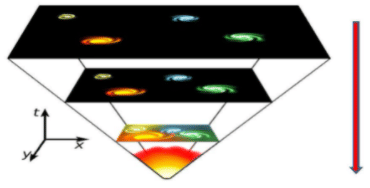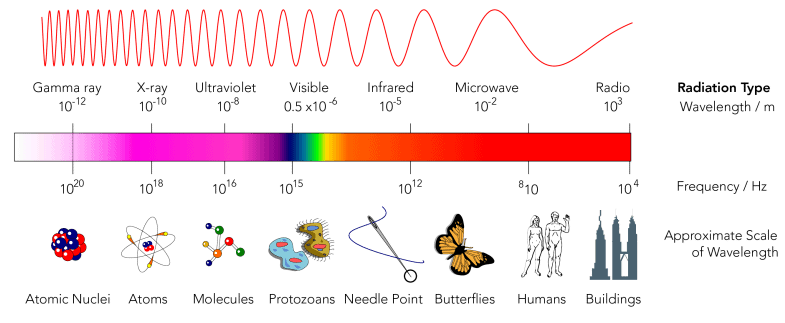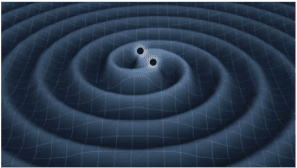Some General Concepts | Science & Technology for UPSC CSE PDF Download
Cosmos: another word for the universe.
Cosmic: relating to the universe or cosmos.
Cosmic rays: highly energetic atomic nucleus or other particle travelling through space at speed approaching that of light. Direct exposure to cosmic rays can cause gene mutations resulting in cancer.
Cosmology: the scientific study of the large-scale properties of the universe as a whole ― NASA
Cosmological: relating to the origin and development of the universe.
Astronomy: the scientific study of celestial objects (stars, planets, comets, etc.) and phenomena that originate outside the Earth’s atmosphere (such as the solar wind, gravitational waves, etc.) ― Sciencedaily.com
- The Universe is all existing matter & space. It is incomprehensibly large (beyond mental grasp).
- The Universe consists of both physical (subatomic particles like electrons, protons to galactic super-clusters) and non-physical (light, gravitation, space etc.) components.
- Most cosmologists believe that the universe was born about 13.8 billion years ago in an event called as Big Bang (a gigantic explosion that caused matter to expand in all directions to form galaxies, stars, etc.)
- The universe, at present, is said to possess about 100 billion galaxies, each comprising an average of 100 billion stars.
In comparison, Milky Way Galaxy is believed to possess 100 billion to 400 billion stars.
1,000,000 = 1 Million = 10 Lakhs; 1,000,000,000 = 1 Billion = 100 Crores; 1000,000,000,000 = 1 Trillion
The Big Bang Theory
 The big bang timeline
The big bang timeline

- The Big Bang theory is the prevailing cosmological model for the birth of the universe.
- It states that at some moment all of space was contained in a single point of very high-density and high-temperature state from which the universe has been expanding in all directions ever since.
- Modern measurements place this moment at approximately 13.8 billion years ago.
- After the initial expansion (inflation), the universe cooled sufficiently to allow the formation of subatomic particles and later simple atoms.
- The majority of atoms produced by the Big Bang were hydrogen and helium along with trace amounts of lithium and beryllium.
- Giant clouds of these primordial elements (hydrogen and helium) later coalesced through gravity to form stars and galaxies.
- According to this theory, the universe, ever since its birth, is expanding in all directions.
- In 1964, the cosmic microwave background radiation was discovered, which was crucial evidence in favour of the Big Bang model.
- Other evidence such as cosmological redshift, gravitational waves, etc. have added weight to the big bang theory.
Big Crunch
- At some point of times, the universe would reach a maximum size and then begin to collapse.
- It would become denser and hotter again, ending with a state similar to that in which it started — a Big Crunch, the death of the universe.

Doppler-shift or Redshift and Blueshift
- Redshift and Blueshift describe how light changes as objects in space (such as stars or galaxies) move closer or farther away from us. The concept is key to charting the universe’s expansion.

- Visible light is a spectrum of colours, which is clear to anyone who has looked at a rainbow.
- When an object moves away from us (Doppler-shifted to lower frequencies), the light is shifted to the red end of the spectrum, as its wavelengths get longer.
- If an object moves closer (Doppler-shifted to higher frequencies), the light moves to the blue end of the spectrum, as its wavelength gets shorter.
- American astronomer Edwin Hubble was the first to describe the redshift phenomenon (galactic redshift) and tie it to an expanding universe (galaxies are drifting apart).
- Hubble’s law: the farther away galaxies are, the faster they are moving away from Earth ― also known as accelerating the expansion of the universe.
Cosmic microwave background (CMD)
- With a traditional optical telescope, the space between stars and galaxies is completely dark.
- However, a sensitive radio telescope shows a faint background glow. This glow is strongest in the microwave region of the radio spectrum, and hence it is called a cosmic microwave background.

- CMB has gone from high energy photons (gamma photons or X-ray photons) to low microwave photons today due to the redshift from the expanding Universe.
- CMD, also known as relic radiation, is almost the same in all directions and it is not associated with any star, galaxy, or other objects. It is the thermal radiation left over from the “Big Bang”.
- The CMB is fundamental to observational cosmology because it is the oldest light in the Universe and can be found in all directions.
- As CMB is the radiation left over from an early stage in the development of the Universe, its discovery is considered a landmark test for the Big Bang model of the Universe.
Accelerating expansion of the universe
- It is the observation that the expansion of the universe is such that the velocity at which a galaxy is moving away from the observer is continuously increasing with time (Hubble’s law).
- It implies that the universe will get increasingly colder as matter spreads across in space.
- The accelerated expansion of the universe is thought to have begun since the universe entered its dark-energy-dominated era roughly 5 billion years ago.
- The accelerated expansion was discovered in 1998 using distant type Ia supernovae to measure the acceleration.
A type Ia supernova is a type of supernova that occurs in binary systems (two stars orbiting one another) in which one of the stars is a white dwarf. The other star can be anything from a giant star to an even smaller white dwarf.
- All Type Ia supernovae are thought to have nearly the same maximum brightness when they explode.
- Such consistency allows them to be used as beacons to measure the rate of expansion of the universe. The weaker the light, the farther away the star is (cosmological redshift).
Dark energy
- Dark energy is an unknown form of energy which is hypothesised to permeate (spread throughout) all of space, tending to accelerate the expansion of the universe.
Related or similar terminology
Dark matter
- The velocity of rotation for spiral galaxies depends on the amount of mass contained in them.
- But the outer arms of the Milky Way are rotating much too fast to be consistent with the amount of matter that we know exists in them.
- Such fast rotation is possible only when there is more mass, and that extra mass is believed to come from the dark matter.
- Dark matter is a hypothetical form of matter that is thought to account for approximately 85% of the matter in the universe.
- Dark energy plus dark matter constitutes 95.1% of the total content of the universe (the rest in the normal matter). In short, we are unsure about what’s there in 95% of the universe!
- The majority of dark matter is thought to be composed of some as-yet-undiscovered subatomic particles.
- The name dark matter refers to the fact that it does not appear to interact with observable electromagnetic radiation, such as light.
- It is thus invisible (or ‘dark’) to the entire electromagnetic spectrum, making it extremely difficult to detect.
- Dark matter interacts with the rest of the universe only through its gravity (that’s how we know it exists).
Anti-Matter
- It is hypothesized that every elementary particle in the Universe has a partner particle, known as an ‘antiparticle’.
- The particle and its antiparticle share many similar characteristics, but many other properties are the exact opposite.
- The electron, for example, has as its antiparticle the antielectron. They both have the same masses, but they have exactly opposite electrical charges.
- Most of the human understanding of the antimatter comes from high energy accelerator experiments.
- When a matter particle meets its antimatter particle, they destroy each other completely (i.e. annihilation), releasing the energy equivalent of their rest masses (following Einstein’s E = mc2).
- For instance, when an electron meets an antielectron, the two annihilate and produce a burst of light which produces a corresponding energy level equivalent to the masses of the two particles.
Gravitational waves
- Gravitational waves are ‘ripples’ in the fabric of space-time caused by some of the most violent and energetic processes in the Universe.
- These ripples travel at the speed of light through the Universe, carrying with them information about their origins.
- Albert Einstein predicted the existence of gravitational waves in 1916 in his general theory of relativity.
- He observed that massive accelerating objects (such as neutron stars or black holes orbiting each other) would disrupt space-time in such a way that ‘waves’ of distorted space would radiate from the source (like the movement of waves away from a stone thrown into a pond).
- In 2015, LIGO (The Laser Interferometer Gravitational-Wave Observatory, USA) physically sensed the distortions in spacetime caused by passing gravitational waves generated by two colliding black holes nearly 1.3 billion light-years away!
 Gravitational waves (NASA)
Gravitational waves (NASA) - While the processes that generate gravitational waves can be extremely violent and destructive, by the time the waves reach Earth, they are billions of times smaller.
Einstein’s theory of general relativity
- In 1905, Albert Einstein determined that the laws of physics are the same for all non-accelerating observers and that the speed of light in a vacuum was independent of the motion of all observers.
- As a result, he found that space and time were interwoven into a single continuum known as space-time.
- Events that occur at the same time for one observer could occur at different times for another. This was the theory of special relativity.
- In 1915, Einstein published his theory of general relativity. In it, he determined that massive objects distort space-time, which is felt as gravity.
- Gravitational lensing and gravitational waves are strong evidence for Einstein’s theory of general relativity.
Gravitational lensing
- Light around a massive object, such as a black hole, is bent, causing it to act as a lens for the things that lie behind it.
Importance of gravitational waves
- The gravitational waves can work as sirens to measure the expansion rate of the universe and to understand the origin and the future of the universe.
- Hubble’s Law: the farther away galaxies are, the faster they are moving away from Earth ― accelerating expansion of the universe).
- Hubble constant: a unit of measurement that describes the rate at which the universe is expanding.
- Two parameters that are essential to estimating the Hubble constant are the distance of the stars from Earth and how fast they are moving away from us (their velocity).
- But to date, the most precise efforts have landed on very different values of the Hubble constant.
- Scientists have proposed a more accurate and independent way to measure the Hubble constant, using gravitational waves.
- A flash of light would give an estimate of the system’s velocity (system: neutron stars or black holes orbiting each other), or how fast it is moving away from the Earth.
- The emitted gravitational waves, if detected on Earth, should provide a precise measurement of the system’s distance.
- By knowing the system’s velocity and distance, a precise calculation of Hubble constant is possible.
|
90 videos|488 docs|209 tests
|
FAQs on Some General Concepts - Science & Technology for UPSC CSE
| 1. What is the importance of learning a second language? |  |
| 2. How does learning a second language improve cognitive abilities? |  |
| 3. Can learning a second language help in career advancement? |  |
| 4. How can learning a second language enhance cultural understanding? |  |
| 5. Are there any age restrictions for learning a second language? |  |
















